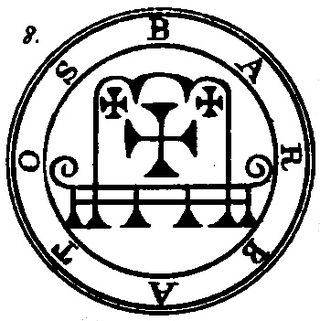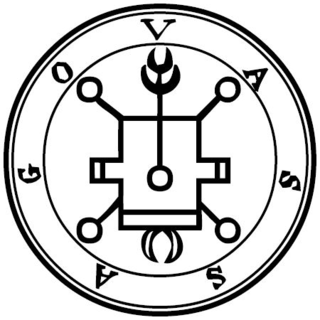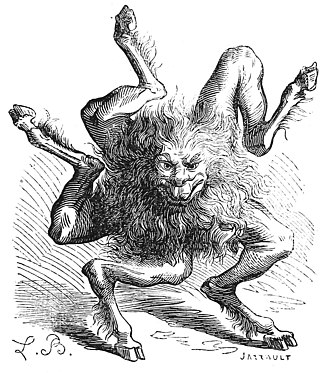
Aamon, in demonology, is a Grand Marquis of Hell who governs 40 infernal legions, and the 7th spirit of the Goetia. He is the demon of life and reproduction.

Barbatos is the 8th spirit named among the list of 72 demons in The Lesser Key of Solomon. According to grimoire tradition, he holds the rank of Duke, and may appear when the sun is in the sign of Sagittarius. When summoned, he appears "with four noble kings and their companions in great troops". Barbatos grants the ability to understand the spoken language of animals, such as the singing of birds and the barking of dogs. He reveals hidden treasures that have been concealed by the enchantment of magicians, gives knowledge of past and future events, and reconciles disputes between friends and those who hold power. Barbatos has 30 legions of spirits under his command, and once belonged to the angelic order of Virtues.

Alloces is a demon that appears in demonological grimoires such as the Liber Officiorum Spirituum, Pseudomonarchia Daemonum, and the Lesser Key of Solomon. He is described in the Lesser Key of Solomon and in the Pseudomonarchia Daemonum as a duke, taking the form of a fire-breathing, lion-headed soldier riding a horse. His purported duties include teaching astronomy, and liberal sciences, and granting familiars. He is claimed to have 36 legions of demons under his command. In the Liber Officiorum Spirituum, Alloces appears as Allogor or Algor, again a duke, but otherwise with a completely different appearance and abilities -- a spear-toting knight who answers questions, provides advice for plans, and commands only 30 legions of demons. In the duplicate entry, Alloces appears as Algor, ruled by the spirit "Orience" (Oriens), again as a knight who explains secrets, but with the additional power of garnering the favor of nobles. According to Rudd, Alloces is opposed by the Shemhamphorasch angel Imamiah.
Vine is a demon listed in demonological grimoires such the Lesser Key of Solomon Johann Weyer's Pseudomonarchia Daemonum, and Jacques Collin de Plancy's Dictionnaire Infernal.
The Lesser Key of Solomon, also known by its Latin title Lemegeton Clavicula Salomonis or simply the Lemegeton, is an anonymously authored grimoire on sorcery, mysticism and magic. It was compiled in the mid-17th century, mostly from materials several centuries older. It is divided into five books: the Ars Goetia, Ars Theurgia-Goetia, Ars Paulina, Ars Almadel, and Ars Notoria. It is based on the Testament of Solomon and the ring mentioned within it that he used to seal demons.
In demonology, Valefar is a Duke of Hell. He tempts people to steal and is in charge of a good relationship among thieves. Valefar is considered a good familiar by his associates "till they are caught in the trap". He commands ten legions of demons.

Vassago is a demon described in demonological grimoires such as the Lesser Key of Solomon and the Book of the Office of Spirits.
Gamigin is a demon described in demonological grimoires such as The Lesser Key of Solomon and Johann Weyer's Pseudomonarchia Daemonum.

Buer is a spirit that appears in the 16th-century grimoire Pseudomonarchia Daemonum and its derivatives, where he is described as a Great President of Hell, having fifty legions of demons under his command. He appears when the Sun is in Sagittarius. Like Chiron, the chief centaur of Greek mythology, he teaches natural and moral philosophy, logic, and the qualities and uses of all herbs and plants, and is also capable of healing all infirmities and bestows good familiars.
Botis, sometimes Otis, is a demon described in the Lesser Key of Solomon and the Pseudomonarchia Daemonum as a President and an Earl who initially appears as a viper before changing into a sword-toting, fanged, and horned human who discusses matters past, present, and future; brings favor from allies and enemies, and rules 60 legions of demons. In the Munich Manual of Demonic Magic, Botis appears as Otius, and is mostly identical except that he is a preses and Count, appears in the more humanoid form to begin with, and rules only 36 legions of demons. In the Grand Grimoire, Botis appears as a subordinate of Agaliarept. According to Rudd, Botis is opposed by the Shemhamphorasch angel Lauviah.
In demonology, Morax is a Demon, Great Earl, and President of Hell, having thirty legions of demons under his command. He teaches Astronomy and all other liberal sciences, and gives good and wise familiars that know the virtues of all herbs and precious stones. This profile of the demon can be seen in Pseudomonarchia Daemonum as well as in Goetia.
Foras or Forrasis, in demonology, is a powerful President of Hell, being obeyed by twenty-nine legions of demons. He teaches logic and ethics in all their branches, the virtues of all herbs and precious stones, can make a man witty, eloquent, invisible, and live long, and can discover treasures and recover lost things.

In demonology, Furfur is a powerful Great Earl of Hell, being the ruler of twenty-six legions of demons. He is a liar unless compelled to enter a magic triangle where he gives true answers to every question, speaking with a rough voice. Furfur causes love between a man and a woman, creates storms, tempests, thunder, lightning, and teaches on secret and divine things.

In demonology, Raum is a Great Earl of Hell, ruling thirty legions of demons. He is depicted as a crow which adopts human form at the request of the conjurer.
"Raum, Reym (Rey) or Raim is a great earle, he is seene as a crowe, but when he putteth on humane shape, at the commandement of the exorcist, he stealeth woonderfullie out of the kings house, and carrieth it whether he is assigned, he destroieth cities, and hath great despite unto dignities, he knoweth things present, past, and to come, and reconcileth freends and foes, he was of the order of thrones, and governeth thirtie legions."

In demonology, Orobas is a powerful Great Prince of Hell, having twenty legions of demons under his control.

Gemory is a demon listed in demonological grimoires.

Valac is a demon described in the goetic grimoires The Lesser Key of Solomon, Johann Weyer's Pseudomonarchia Daemonum, the Liber Officiorum Spirituum, and in the Munich Manual of Demonic Magic as an angelically winged boy riding a two-headed dragon, attributed with the power of finding treasures.

Christian demonology is the study of demons from a Christian point of view. It is primarily based on the Bible, the interpretation of these scriptures, the writings of early Christianity philosophers, hermits, and the associated traditions and legends incorporated from other beliefs.

There have been various attempts at the classification of demons within the contexts of classical mythology, demonology, occultism, and Renaissance magic. These classifications may be for purposes of traditional medicine, exorcisms, ceremonial magic, witch-hunts, lessons in morality, folklore, religious ritual, or combinations thereof. Classifications might be according to astrological connections, elemental forms, noble titles, or parallels to the angelic hierarchy; or by association with particular sins, diseases, and other calamities; or by what angel or saint opposes them.












